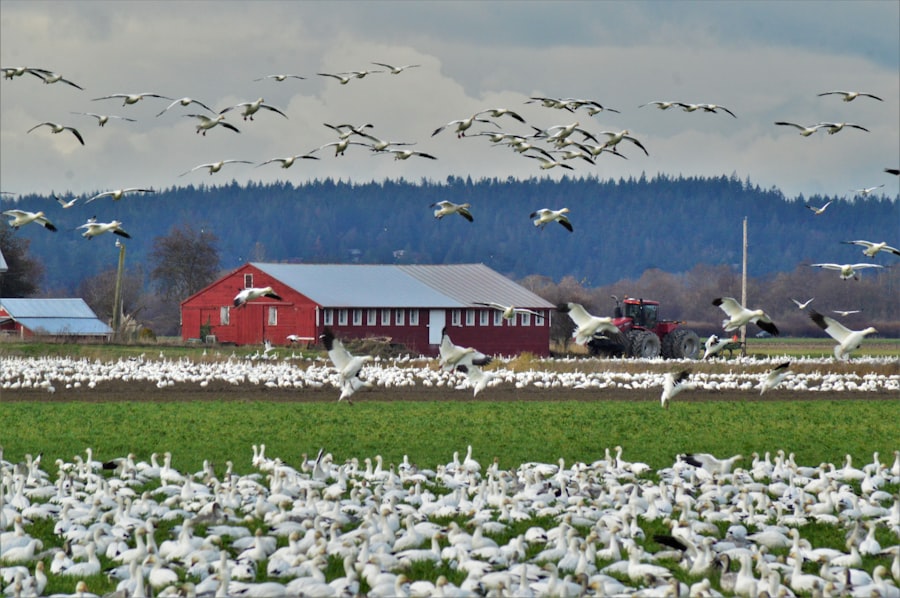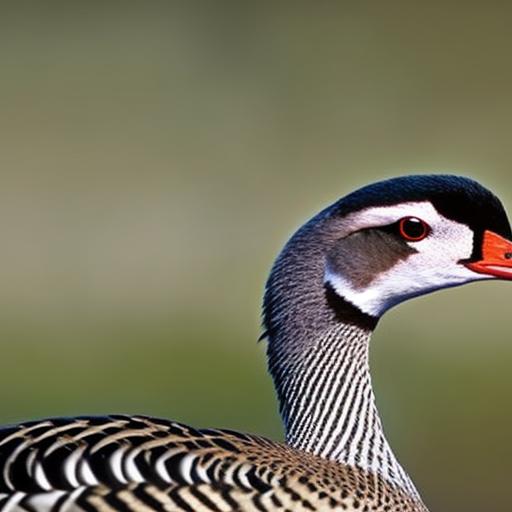Geese have been domesticated for thousands of years, with evidence of their presence in ancient Egypt and Rome. These birds were initially kept for their meat, eggs, and feathers, but over time, they have become valued for their role in agriculture. Tame geese are known for their ability to control pests, provide high-quality meat and eggs, and even contribute to the production of fertilizer. Their versatility and usefulness make them a great addition to any farm.
Key Takeaways
- Tame geese breeds are a great addition to any farm due to their many benefits.
- Raising tame geese can provide a source of meat, eggs, and feathers.
- Tame geese breeds are known for their docile and friendly nature.
- Popular tame geese breeds include the Embden, Toulouse, and Chinese geese.
- Taming and training tame geese requires patience and consistency.
Benefits of Raising Tame Geese
One of the main benefits of raising tame geese is their natural pest control abilities. Geese are excellent at foraging and can help keep your farm free from unwanted insects and weeds. They have a keen eye for spotting pests and will eagerly devour them, reducing the need for chemical pesticides. This not only saves you money but also promotes a healthier and more sustainable farming practice.
In addition to pest control, tame geese also provide high-quality meat and eggs. The meat of geese is known for its rich flavor and tenderness, making it a popular choice among chefs and food enthusiasts. Geese eggs are larger than chicken eggs and have a higher yolk-to-white ratio, resulting in a richer taste. Both the meat and eggs of geese are highly nutritious, making them a valuable addition to any diet.
Another benefit of raising tame geese is their contribution to fertilizer production. Geese produce large amounts of manure, which can be used as a natural fertilizer for crops. Their droppings are rich in nitrogen, phosphorus, and potassium, essential nutrients for plant growth. By allowing your geese to roam freely in your fields or using their manure as compost, you can improve soil fertility and promote healthy crop growth.
Furthermore, tame geese provide a valuable resource in the form of feathers. Their feathers are highly prized for their softness and insulation properties, making them ideal for down and pillow production. By raising geese, you can harvest their feathers and sell them or use them for your own purposes. This adds another income stream to your farm and reduces waste.
Characteristics of Tame Geese Breeds
Tame geese come in various breeds, each with its own unique characteristics. When choosing a breed, it is important to consider factors such as size, feather color and pattern, as well as temperament and behavior.
Size and weight can vary greatly among tame geese breeds. Some breeds, like the Embden and Toulouse, are large and heavy, weighing up to 20 pounds or more. These breeds are known for their meat production and are often raised for their size. On the other hand, breeds like the African and Chinese geese are smaller in size, weighing around 10-12 pounds. These breeds are valued for their egg production and are popular among backyard farmers.
Feather color and pattern also differ among tame geese breeds. The Embden goose has pure white feathers, while the Toulouse goose has gray feathers with a white underbelly. African geese have a striking combination of black and white feathers, while Chinese geese have a solid gray or brown coloration. Sebastopol geese have unique curly feathers that give them a distinctive appearance.
Temperament and behavior can vary among tame geese breeds as well. Some breeds, like the Embden and Toulouse, are known for their calm and docile nature, making them easier to handle and train. African geese, on the other hand, can be more aggressive and territorial, requiring careful handling and socialization. Chinese geese are known for their loud honking and alert nature, making them excellent watchdogs.
Popular Tame Geese Breeds
There are several popular tame geese breeds that are commonly raised for their various benefits. These breeds include the Embden, Toulouse, African, Chinese, and Sebastopol geese.
The Embden goose is one of the largest and heaviest tame geese breeds. It has pure white feathers and a calm and docile temperament. The Embden goose is known for its meat production and is often raised for its size. It is also a good egg producer, making it a versatile breed for both meat and egg production.
The Toulouse goose is another large breed with gray feathers and a white underbelly. It is known for its calm and friendly nature, making it a popular choice among farmers. The Toulouse goose is valued for its meat production and is often raised for its size. It is also a good egg producer, making it a dual-purpose breed.
The African goose is a medium-sized breed with striking black and white feathers. It has a more aggressive temperament compared to other breeds and requires careful handling and socialization. The African goose is valued for its egg production and is often raised for its ability to lay large eggs consistently.
The Chinese goose is a medium-sized breed with solid gray or brown feathers. It is known for its loud honking and alert nature, making it an excellent watchdog. The Chinese goose is valued for its egg production and is often raised for its ability to lay large eggs consistently.
The Sebastopol goose is a medium-sized breed with unique curly feathers that give it a distinctive appearance. It has a calm and friendly temperament, making it easy to handle and train. The Sebastopol goose is valued for its ornamental qualities and is often raised for exhibition purposes.
Taming and Training Tame Geese
Taming and training tame geese requires patience, consistency, and positive reinforcement techniques. It is important to start socializing your geese from a young age to ensure they become comfortable with human interaction.
Socialization involves spending time with your geese, talking to them, and gently handling them. This helps them become familiar with your presence and reduces their fear of humans. It is important to approach your geese calmly and avoid sudden movements or loud noises that may startle them.
Positive reinforcement techniques, such as rewards and praise, can be used to train your geese. Geese are intelligent animals and can learn to respond to commands and cues. By rewarding desired behaviors with treats or praise, you can reinforce these behaviors and encourage your geese to repeat them.
Training for obedience and tricks can also be done with tame geese. Geese can learn to follow simple commands, such as “come” or “stay,” through consistent training and repetition. They can also be taught to perform tricks, such as shaking hands or jumping through hoops. Training sessions should be short and frequent to keep your geese engaged and motivated.
Feeding and Housing Tame Geese

Feeding tame geese requires providing them with a balanced diet that meets their nutritional requirements. Geese are herbivores and primarily feed on grass, weeds, and other vegetation. However, they also require additional feed and supplements to ensure they receive all the necessary nutrients.
Geese require a diet that is high in protein, especially during the breeding season. This can be achieved by providing them with a commercial waterfowl feed that is specifically formulated for geese. The feed should contain a balance of grains, seeds, and protein sources such as soybean meal or fish meal.
In addition to commercial feed, geese should have access to fresh water at all times. They require water for drinking as well as for bathing and preening their feathers. A shallow pool or pond should be provided for them to swim in and keep their feathers clean.
Ideal housing conditions for tame geese include a secure shelter or coop that protects them from predators and extreme weather conditions. The shelter should be well-ventilated and provide enough space for the geese to move around comfortably. Bedding material, such as straw or wood shavings, should be provided to keep the geese warm and comfortable.
Health and Care of Tame Geese
Keeping your tame geese healthy requires regular grooming and hygiene practices, as well as providing them with proper veterinary care. Geese are generally hardy birds but can be susceptible to certain health issues if not properly cared for.
Common health issues in geese include respiratory infections, parasites, and foot problems. Regular grooming, such as trimming their wings and nails, can help prevent injuries and infections. It is also important to regularly clean their living area and provide them with fresh bedding to maintain good hygiene.
Veterinary care is essential for the health of your tame geese. Regular check-ups and vaccinations can help prevent diseases and ensure your geese are in good health. It is important to find a veterinarian who is experienced in treating geese and can provide the necessary care and advice.
Breeding Tame Geese
Breeding tame geese involves understanding their mating habits and providing the necessary conditions for successful breeding. Geese are monogamous birds and form lifelong pair bonds with their mates.
The breeding season for geese typically begins in late winter or early spring. During this time, the male goose, known as the gander, will perform courtship displays to attract a mate. These displays involve honking, head bobbing, and wing flapping to impress the female goose.
Once a pair bond is formed, the female goose, known as the goose, will lay a clutch of eggs. The number of eggs laid can vary depending on the breed but is typically around 5-10 eggs. The eggs are incubated for about 28-30 days until they hatch.
Caring for goslings involves providing them with a safe and warm environment. Goslings are vulnerable to predators and require protection during their early stages of life. They should be kept in a brooder or separate enclosure until they are old enough to join the adult geese.
Uses of Tame Geese in Agriculture
Tame geese have a wide range of uses in agriculture, making them a valuable asset on any farm. Some of the main uses of tame geese include weed and insect control, fertilizer production, meat and egg production, as well as feather and down production.
Geese are excellent at controlling weeds and insects in fields and pastures. They have a voracious appetite for grass, weeds, and other vegetation, helping to keep unwanted plants under control. They also have a keen eye for spotting pests such as slugs, snails, and insects, reducing the need for chemical pesticides.
Geese produce large amounts of manure, which can be used as a natural fertilizer for crops. Their droppings are rich in nitrogen, phosphorus, and potassium, essential nutrients for plant growth. By allowing your geese to roam freely in your fields or using their manure as compost, you can improve soil fertility and promote healthy crop growth.
Meat and egg production is another valuable use of tame geese in agriculture. Geese meat is known for its rich flavor and tenderness, making it a popular choice among chefs and food enthusiasts. Geese eggs are larger than chicken eggs and have a higher yolk-to-white ratio, resulting in a richer taste. Both the meat and eggs of geese are highly nutritious, making them a valuable addition to any diet.
Feathers from tame geese can be harvested and used for various purposes. Their feathers are highly prized for their softness and insulation properties, making them ideal for down and pillow production. By raising geese, you can harvest their feathers and sell them or use them for your own purposes. This adds another income stream to your farm and reduces waste.
Why Tame Geese Breeds are a Great Addition to Your Farm
In conclusion, tame geese breeds are a great addition to any farm due to their versatility and usefulness in agriculture. They provide natural pest control, high-quality meat and eggs, fertilizer for crops, as well as feathers for down and pillow production. Tame geese breeds come in various sizes, feather colors, and patterns, each with its own unique characteristics. They can be tamed and trained using positive reinforcement techniques and require a balanced diet and proper housing conditions. Regular grooming and veterinary care are essential for their health and well-being. Breeding tame geese involves understanding their mating habits and caring for goslings. Tame geese have a wide range of uses in agriculture, including weed and insect control, fertilizer production, meat and egg production, as well as feather and down production. They are a low-maintenance and high-yield option for sustainable and eco-friendly farming practices. Additionally, they provide enjoyment and companionship on the farm. Overall, tame geese breeds are a valuable asset that can enhance the productivity and sustainability of your farm.
If you’re interested in learning more about taming geese breeds, you might find this article on “Turning a Shed into a Chicken Coop” from Poultry Wizard quite helpful. It provides valuable insights and tips on how to create a suitable living space for your geese. Additionally, if you’re curious about the incubation period for goose eggs, Poultry Wizard has another informative article that covers this topic in detail. You can check it out here: “What is the Incubation Period for Goose Eggs?” Lastly, if you’re looking for information on chicken coop door size, Poultry Wizard has got you covered with their article that discusses the importance of choosing the right door size for your chicken coop. Feel free to explore it here: “Chicken Coop Door Size”.
FAQs
What are tame geese breeds?
Tame geese breeds are domesticated geese that have been selectively bred for their docile and friendly temperament. These geese are often kept as pets or for ornamental purposes.
What are some examples of tame geese breeds?
Some examples of tame geese breeds include the Embden, Toulouse, and Pilgrim geese. These breeds are known for their calm and friendly personalities.
What are the benefits of keeping tame geese?
Keeping tame geese can provide a number of benefits, including companionship, pest control, and egg production. Tame geese can also be used for meat production, although this is less common.
What is the lifespan of a tame goose?
The lifespan of a tame goose can vary depending on the breed and living conditions, but they typically live for 10-20 years.
What do tame geese eat?
Tame geese typically eat a diet of grass, grains, and vegetables. They may also be fed commercial poultry feed.
What kind of housing do tame geese need?
Tame geese require a secure and spacious outdoor area to roam and graze, as well as a sheltered area for protection from the elements. They also need access to clean water for drinking and bathing.
Can tame geese be trained?
Yes, tame geese can be trained to follow basic commands and even perform tricks. However, training requires patience and consistency.
Meet Walter, the feathered-friend fanatic of Florida! Nestled in the sunshine state, Walter struts through life with his feathered companions, clucking his way to happiness. With a coop that’s fancier than a five-star hotel, he’s the Don Juan of the chicken world. When he’s not teaching his hens to do the cha-cha, you’ll find him in a heated debate with his prized rooster, Sir Clucks-a-Lot. Walter’s poultry passion is no yolk; he’s the sunny-side-up guy you never knew you needed in your flock of friends!







